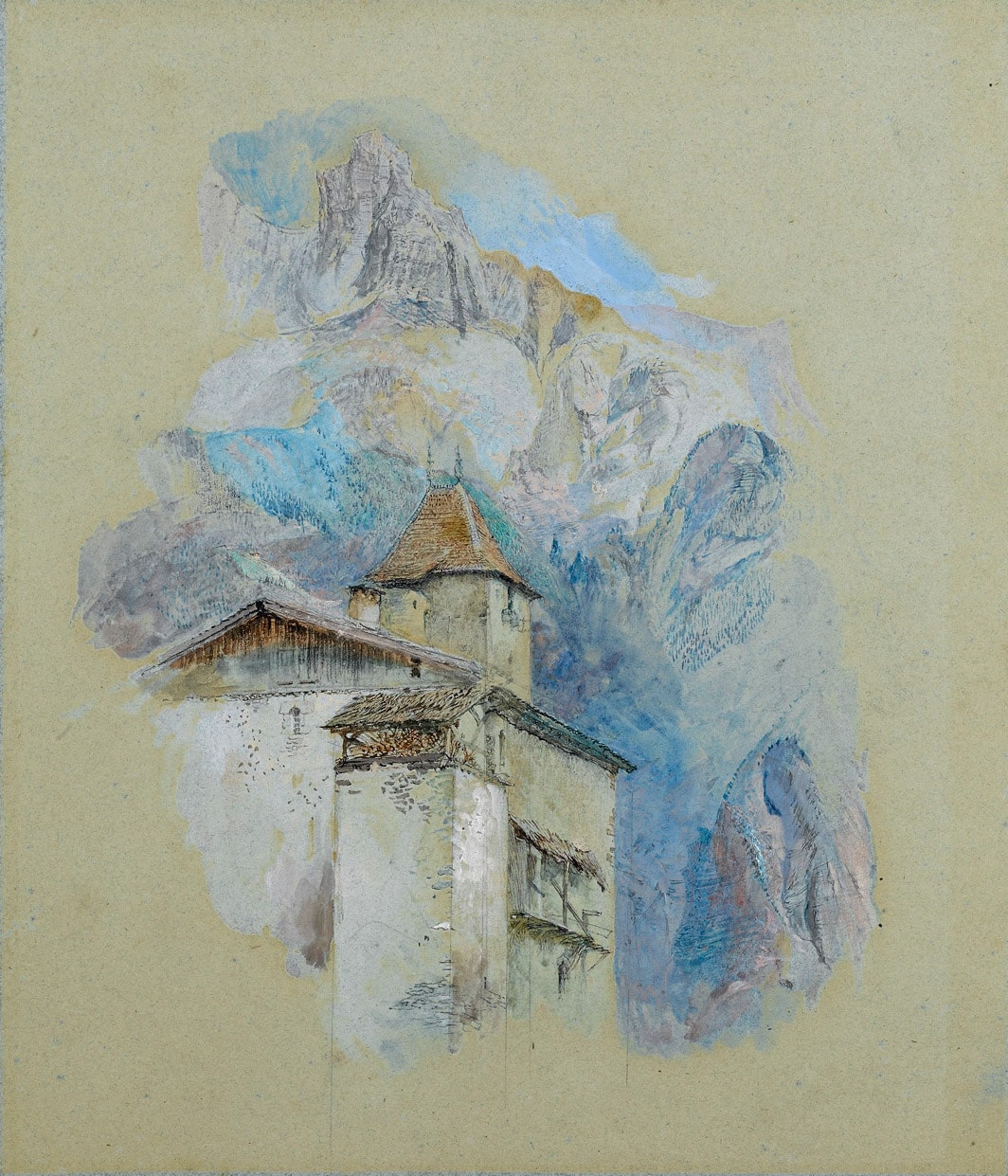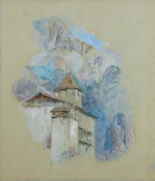John RUSKIN
(London 1819 - Brantwood 1900)
The Chateau des Rubins at Sallanches, with the Aiguille des Varens Beyond
Sold
Watercolour and gouache, over an underdrawing in pencil, on faded blue paper.
215 x 193 mm. (8 1/2 x 7 5/8 in.) [sheet]
215 x 193 mm. (8 1/2 x 7 5/8 in.) [sheet]
This splendid watercolour is a view of the Chateau des Rubins in the town of Sallanches in the French Alps, looking towards the mountain peak known as the Aiguille de Varens. Ruskin seems to have taken his view from the gorge of Levaux at Sallanches, which is in the French departement of Haute-Savoie. The 14th century Chateau des Rubins depicted in the foreground still stands; one of the few surviving buildings from a fire that destroyed much of Sallanches in the 1840’s. (The chateau today houses a local museum, the Centre de la Nature Montagnard.) David Hill was the first to identify this view as of the Chateau des Rubins, and has dated the drawing to about 1860, when Ruskin spent a considerable amount of time in Sallanches.
Ruskin’s first visit to the area around Sallanches took place during his inaugural trip to France, Switzerland and Italy with his parents in 1833. Two years later, at the age of sixteen, Ruskin returned with his family to Sallanches on a second Continental journey that took up most of the second half of 1835. In a long poem written that year describing his travels, entitled Journal of a Tour through France to Chamouni, Ruskin wrote: ‘Oh, gently sinks the eve, and red doth set / The sun above Sallenches’ mountains blue; / Like regal robes, the purple clouds beset / Mont Blanc; but on his crest, still breaking through, / The last bright western rays are lingering yet, / And the white snow glows with a rosy hue.’ In 1849 Ruskin made two drawings of the Aiguille de Varens, both of which are listed in the ‘Catalogue of Sketches in neighbourhood of Mont Blanc’ in his diary of 1854.
Ruskin returned several times to Sallanches over the succeeding years, up to his final tour in 1888, and often recorded in his diaries and letters his delight in the views of the mountains from the town and the surrounding countryside. In 1854 he wrote, ‘Sallenches. How little I thought God would bring me here again just now - and I am here, stronger in health, higher in hope, deeper in peace, than I have been for years. The green pastures and pine forests of the Varens softly seen through the light of my window. I cannot be thankful enough, nor happy enough.’ In another diary entry of the same year, describing a walk on a hillside near Sallanches, Ruskin noted ‘And opposite always the mighty Varens lost in the cloud its ineffable walls of crag.’
In the autumn and winter of 1862 and the spring of 1863 Ruskin spent several months in the Haute-Savoie, visiting the sites of Turner’s watercolours and working on a book about Swiss towns. Twenty years later, while staying at Sallanches in September 1882, he wrote that ‘I have never been happier in seeing the Alps once more, nor felt more desire to do better work on them than ever yet. And I was never so persecuted by the storms and clouds…But, at last, 9 o’clock, the dingy clouds seem breaking from the Aiguilles du Goûté and de Bionnassay, and there is blue sky beyond the Varens.’ A few days later he added, ‘Mont Blanc entirely clear all the morning; fresh snow in perfect light on the Dorons; and the Varens a miracle of aerial majesty.’
This fine study is clearly influenced by the late watercolours of Swiss mountain scenes by J. M. W. Turner. In 1851 Ruskin was appointed an executor of Turner’s estate, and chose the master’s Swiss mountain views as the subject of his first exhibition. In 1856 he decided to embark on a series of Swiss mountain views, which resulted in, as Walton has described them, ‘a series of remarkably expressive drawings…and certainly his best work.’
This drawing was, in fact, previously identified as a view of Fribourg in Switzerland, and indeed the drawing is close in style to Ruskin’s views of Fribourg dating from the mid- to late 1850’s, such as a two studies of The Towers of Fribourg and Houses at Fribourg in the British Museum and a drawing of The Augustinian Convent in Fribourg in the David Thomson collection in Toronto; the latter two drawings are, like many of the artist’s Swiss views, on blue paper. Such watercolours as the present sheet have been suitably described as ‘Elegant delineations of buildings, mountains and skies [which] were composed with almost oriental fastidiousness within expanses of blank paper, and the effect may be as cool as moonlight or as hot as Mediterranean sunshine.’
In September 1888, when the aged Ruskin was staying at an inn at Sallanches on his final Continental tour, a fellow guest recalled his brief meeting with him in his memoirs, published many years later: ‘He looked much older than in Oxford ten years ago…We were looking across the fertile valley to the red precipices of the Varens, which rose sheer opposite the window, and he said there was no place like Sallanches for beauty and sublimity combined. “And yet”, I said, ‘hardly a soul comes here to stay”. ‘Very few people have souls”, he answered, “and those that have are generally ambitious and want to climb heights. Hardly anyone cares about beauty”.’
Ruskin’s first visit to the area around Sallanches took place during his inaugural trip to France, Switzerland and Italy with his parents in 1833. Two years later, at the age of sixteen, Ruskin returned with his family to Sallanches on a second Continental journey that took up most of the second half of 1835. In a long poem written that year describing his travels, entitled Journal of a Tour through France to Chamouni, Ruskin wrote: ‘Oh, gently sinks the eve, and red doth set / The sun above Sallenches’ mountains blue; / Like regal robes, the purple clouds beset / Mont Blanc; but on his crest, still breaking through, / The last bright western rays are lingering yet, / And the white snow glows with a rosy hue.’ In 1849 Ruskin made two drawings of the Aiguille de Varens, both of which are listed in the ‘Catalogue of Sketches in neighbourhood of Mont Blanc’ in his diary of 1854.
Ruskin returned several times to Sallanches over the succeeding years, up to his final tour in 1888, and often recorded in his diaries and letters his delight in the views of the mountains from the town and the surrounding countryside. In 1854 he wrote, ‘Sallenches. How little I thought God would bring me here again just now - and I am here, stronger in health, higher in hope, deeper in peace, than I have been for years. The green pastures and pine forests of the Varens softly seen through the light of my window. I cannot be thankful enough, nor happy enough.’ In another diary entry of the same year, describing a walk on a hillside near Sallanches, Ruskin noted ‘And opposite always the mighty Varens lost in the cloud its ineffable walls of crag.’
In the autumn and winter of 1862 and the spring of 1863 Ruskin spent several months in the Haute-Savoie, visiting the sites of Turner’s watercolours and working on a book about Swiss towns. Twenty years later, while staying at Sallanches in September 1882, he wrote that ‘I have never been happier in seeing the Alps once more, nor felt more desire to do better work on them than ever yet. And I was never so persecuted by the storms and clouds…But, at last, 9 o’clock, the dingy clouds seem breaking from the Aiguilles du Goûté and de Bionnassay, and there is blue sky beyond the Varens.’ A few days later he added, ‘Mont Blanc entirely clear all the morning; fresh snow in perfect light on the Dorons; and the Varens a miracle of aerial majesty.’
This fine study is clearly influenced by the late watercolours of Swiss mountain scenes by J. M. W. Turner. In 1851 Ruskin was appointed an executor of Turner’s estate, and chose the master’s Swiss mountain views as the subject of his first exhibition. In 1856 he decided to embark on a series of Swiss mountain views, which resulted in, as Walton has described them, ‘a series of remarkably expressive drawings…and certainly his best work.’
This drawing was, in fact, previously identified as a view of Fribourg in Switzerland, and indeed the drawing is close in style to Ruskin’s views of Fribourg dating from the mid- to late 1850’s, such as a two studies of The Towers of Fribourg and Houses at Fribourg in the British Museum and a drawing of The Augustinian Convent in Fribourg in the David Thomson collection in Toronto; the latter two drawings are, like many of the artist’s Swiss views, on blue paper. Such watercolours as the present sheet have been suitably described as ‘Elegant delineations of buildings, mountains and skies [which] were composed with almost oriental fastidiousness within expanses of blank paper, and the effect may be as cool as moonlight or as hot as Mediterranean sunshine.’
In September 1888, when the aged Ruskin was staying at an inn at Sallanches on his final Continental tour, a fellow guest recalled his brief meeting with him in his memoirs, published many years later: ‘He looked much older than in Oxford ten years ago…We were looking across the fertile valley to the red precipices of the Varens, which rose sheer opposite the window, and he said there was no place like Sallanches for beauty and sublimity combined. “And yet”, I said, ‘hardly a soul comes here to stay”. ‘Very few people have souls”, he answered, “and those that have are generally ambitious and want to climb heights. Hardly anyone cares about beauty”.’
John Ruskin drew constantly, and although he received some training from artists such as Copley Fielding and James Duffield Harding, his talents as a draughtsman were to a large extent the result of natural gifts. As the young Ruskin noted in a letter of his mother of 1845, ‘Architecture I can draw like an architect, and trees a good deal better than most botanists, and mountains rather better than most geologists.’
For the most part, Ruskin’s drawings were not intended for exhibition, but rather as a complement to his written work. As Paul Walton has noted, Ruskin’s voluminous writings, in the form of books, diaries, essays, articles and letters, are enriched by the study of his ‘watercolours and sketches of the mountains and skies, cottages and cathedrals, stones and flowers in which he found inscribed the messages that guided his life’s work as an interpreter of nature and art.’
Provenance
Villiers David
His posthumous sale, London, Christie’s, 19 November 1985, lot 210
Anonymous sale, London, Christie’s, 12 July 1994, lot 110
Private collection, London
Anonymous sale, New York, Sotheby’s, 25 January 2002, lot 162
Anonymous sale, London, Sotheby’s, 25 November 2004, lot 176
Andrew Wyld, London, in 2005.







